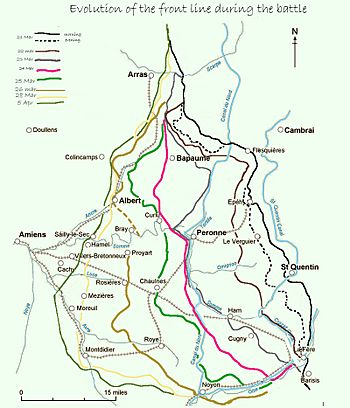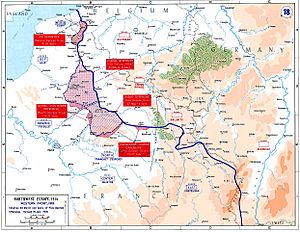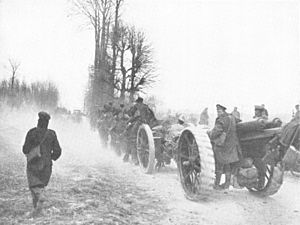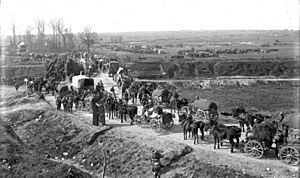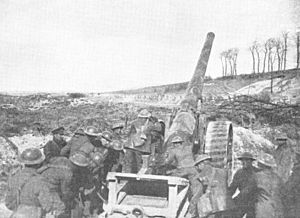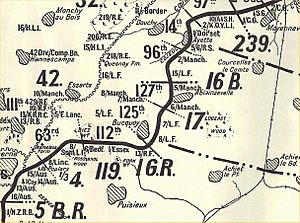Operation Michael facts for kids
Quick facts for kids Operation Michael |
|||||||||
|---|---|---|---|---|---|---|---|---|---|
| Part of the German Spring Offensive in World War I | |||||||||
|
Evolution of the front line during the battle |
|||||||||
|
|||||||||
| Belligerents | |||||||||
|
|||||||||
| Commanders and leaders | |||||||||
| Strength | |||||||||
| 72 divisions |
|
||||||||
| Casualties and losses | |||||||||
| 239,800 |
|
||||||||
Operation Michael (German: Unternehmen Michael) was a huge German attack during World War I. It started on March 21, 1918, and was the first part of the German Spring Offensive. The goal was to break through the lines of the Allied forces (Britain and France) in France.
The Germans wanted to push north-west to capture the Channel Ports. These ports were super important for supplying the British Army (BEF). The plan was to trap the BEF and force them into the sea. Later, the German leader, General Erich Ludendorff, changed the plan. He wanted to attack west to separate the French and British Armies first.
The attack finally stopped near Villers-Bretonneux, east of Amiens. The Allies managed to hold the line. The German army had lost many soldiers and couldn't get enough supplies to their troops who had advanced so far. Much of the fighting happened on the same land as the Battle of the Somme in 1916. This battle was a turning point. Its failure meant the beginning of the end of World War I for Germany. Soon, many American soldiers arrived in France, which helped the Allies recover their strength.
Contents
Why the Battle Happened
Germany's Big Plan
In November 1917, German military leaders talked about a major attack on the Western Front in spring 1918. They believed the British Army (BEF) was tired from earlier battles. General Erich Ludendorff decided to attack on January 21, 1918.
By early 1918, people in Germany were starving and tired of the war. Ludendorff moved almost 50 divisions from the Eastern Front to the Western Front. This meant Germany had more troops than the Allies there. They had 192 divisions on the Western Front by March 21.
The Germans knew they had to win quickly. They wanted to defeat the Allies before many American soldiers arrived. The United States was sending hundreds of thousands of troops to France.
Germany's plan for the 1918 Spring Offensive (called Kaiserschlacht, or Kaiser's Battle) had four main attacks: Michael, Georgette, Gneisenau, and Blücher–Yorck. Operation Michael was the first. Ludendorff wanted to push across the Somme River. Then, he planned to turn north-west to cut off British supply lines and trap the BEF.
New Ways of Fighting
The German army trained with new "open-warfare" tactics. These had worked well on the Eastern Front. They developed special units called stormtroopers (Stoßtruppen). These were elite soldiers who used "infiltration tactics." They moved quickly in small groups, finding weak spots and gaps in enemy defenses.
Stormtroopers would go around heavily defended areas. Other infantry units would then deal with these isolated spots. The stormtroopers' main goal was to move fast and disrupt the enemy. They attacked headquarters, artillery, and supply depots behind the front lines. The best soldiers were put into these storm units. This gave Germany a strong start but meant their best troops would suffer the most losses.
Artillery tactics also changed. Ludendorff used many guns and mortars for "hurricane" bombardments. These were short but very intense. They focused on enemy artillery, machine-gun positions, and communication centers. The goal was to surprise the enemy and stop them from fighting back. After a few hours, the infantry would attack behind a "creeping barrage" (a moving wall of artillery fire).
The British had also started using a "defense in depth" system. This meant fewer troops were in the very front lines. Instead, they had snipers, patrols, and machine-gun posts there. Most of their reserves and supplies were kept further back, away from German artillery.
Getting Ready for Battle
Germany's Attack Plan
The Germans decided to attack the area around St. Quentin. This part of the front had been taken over by the British from the French.
The German attacking armies stretched along a 43-mile (70 km) front. Ludendorff gathered 74 divisions, 6,600 guns, 3,500 mortars, and 326 fighter planes. The main attack force was the 18th Army, with 27 divisions. Many of these divisions were made "mobile" and brought to full strength. Soldiers over 35 were moved out, and each division got more machine-guns, air support, and communication units.
Training focused on moving fast, silencing machine-guns, and keeping in touch with artillery. Infantry got light machine-guns and rifle grenades. Thirty divisions were trained in these new tactics.
British Defenses
In the north, the British Third Army defended the area from Arras south. To the south, the Fifth Army held the line down to where it met the French forces. The Fifth Army had the longest front line for the British, with 12 divisions and 3 cavalry divisions.
British intelligence knew a German attack was coming. Air photos and information from German deserters showed German preparations. New supply roads were built, and shell craters were turned into hidden mortar positions. British planes saw many German transports moving towards St. Quentin.
A few days before the attack, two German deserters told the British that a huge offensive was planned for the next morning. They described many troops, artillery, and trench mortars gathering. On the night of March 20, British troops captured more prisoners who confirmed the attack would start the next day.
At the time of the attack, the Fifth Army's defenses were not fully ready. The very back defensive zone was only marked out. The main "Battle Zone" had small forts that didn't fully support each other. This made them weak if Germans got between them.
At 4:40 AM on March 21, a massive German artillery barrage began. It hit the entire Fifth Army front and most of the Third Army's front.
The Battle Begins
Battle of St. Quentin, March 21–23
Day 1: March 21
And then, exactly as a pianist runs his hands across the keyboard from treble to bass, there rose in less than one minute the most tremendous cannonade I shall ever hear...It swept round us in a wide curve of red leaping flame stretching to the north far along the front of the Third Army, as well as of the Fifth Army on the south, and quite unending in either direction...the enormous explosions of the shells upon our trenches seemed almost to touch each other, with hardly an interval in space or time...The weight and intensity of the bombardment surpassed anything which anyone had ever known before.
The German artillery attack started at 4:35 AM. It was incredibly intense, hitting British positions for miles deep. Over 3.5 million shells were fired in just five hours. This was the biggest artillery attack of the war. The front lines were badly damaged, and communication lines were cut.
When the German infantry attacked at 9:40 AM, they had mixed success. A thick fog helped them move forward without being seen. The fog and smoke made it hard to see all day. This allowed German soldiers to sneak deep behind British lines. Many British front-line positions fell quickly because communications were down.
By midday, German troops broke through south-west of St. Quentin. They pushed several miles forward. The British Fifth Army commander, General Gough, ordered his troops to hold on as long as possible but to retreat if needed to stay connected with other units.
In the Third Army area, Germans also broke through. By the end of the day, the Germans had broken through the British front lines and pushed into the main battle zone. General Gough ordered a fighting retreat. This meant his troops would fight while falling back to gain time for reinforcements. The first day was costly for both sides. The Germans lost about 40,000 men, slightly more than the British.
Day 2: March 22
On the second day, British troops kept falling back. Thick fog again made it hard to see. Soldiers fought in small, isolated groups, often not knowing who was next to them. Many acts of bravery happened as small groups fought to delay the Germans.
The biggest danger was that the British Third and Fifth Armies might get separated. The British commander, General Haig, ordered his generals to stay in contact, even if it meant more retreating. French troops also started to arrive to help on the southern side.
Some British units fought to the last man, like the 16th Manchesters at "Manchester Hill." Other units held out for hours, then retreated when their ammunition ran out. The longest retreat happened in the XVIII Corps area, where troops fell back almost 9 miles (14 km). Engineers blew up bridges to slow the Germans.
Day 3: March 23
On March 23, German troops broke through the British line at the Canal de Saint-Quentin. The fog still helped the Germans bring up fresh troops unseen. British units found themselves surrounded. All defensive lines were overrun.
Lieutenant Alfred Herring led a counter-attack that recaptured a bridge on the Crozat Canal. His small group held it for 12 hours before being captured. The British continued to retreat, often exhausted.
Ludendorff gave new orders. The German 17th Army was to attack towards Arras. The 2nd Army was to attack west towards Amiens, a vital railway center. The 18th Army was to go south-west, stopping French reinforcements and threatening Paris. However, the German advance was slowing down. Their soldiers were tired, and it was hard to bring supplies and heavy artillery forward.
Fighting at the Somme Crossings, March 24–25
Day 4: March 24
By this point, the front line was very messy. British units were mixed up and fighting in small groups. German units also advanced unevenly. Soldiers on both sides were extremely tired.
The British official historian, Sir James Edward Edmonds, wrote that the troops were "tired almost to the limits of endurance." The fighting, heavy losses, and rumors made morale low.
The Germans continued to push. British troops, supported by French infantry, tried to hold the line. But the French received orders to retreat, leaving the British exposed. By nightfall, the British had lost the line of the Somme River.
Day 5: March 25
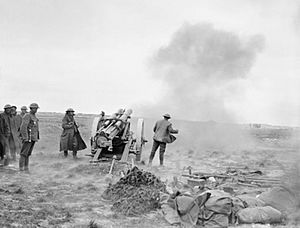
March 25 was a very confusing day. Reports from different units often didn't match. An officer described it as "constant taking up of new positions, followed by constant orders to retire, terrible blocks on the roads, inability to find anyone anywhere."
The British continued to retreat. The town of Nesle was captured by the Germans. French forces on the far right of the line were also pushed back.
The Royal Flying Corps (British air force) flew low to machine-gun and bomb German ground targets. They were very active west of Bapaume. British cavalry helped slow the German advance. That night, the British Third Army reached new positions, but large gaps appeared in their lines.
Battle of Rosières, March 26–27
Day 6: March 26
On March 26, Allied leaders met at Doullens. Important politicians and generals were there, including the French President and British Prime Minister. They decided that General Foch would take command of all Allied forces on the Western Front. They agreed to stop the Germans east of Amiens. More French troops would reinforce the British Fifth Army.
Ludendorff gave new, ambitious orders for his armies, including capturing Amiens. However, the German 17th Army faced strong resistance. A gap in the British line was held by newly arrived New Zealand troops and British "Whippet" tanks. These tanks were faster and lighter, and this was their first time in action. They surprised the Germans, causing them to flee or surrender.
Day 7: March 27
The town of Albert was given up by the British during the night of March 26/27. German troops occupied it and looted supplies. March 27 saw continuous fighting as the British XIX Corps defended against German attacks from all sides around Rosières. The important communication center of Montdidier was lost by the French.
Third Battle of Arras, March 28–29
Day 8: March 28
The main German attack shifted again on March 28. This time, 29 German divisions attacked the British Third Army around Arras. But the British pushed them back. The German troops attacking the Fifth Army had advanced about 40 miles (64 km) by this time, reaching Montdidier.
General Rawlinson replaced General Gough, who was removed from command despite leading a long and difficult retreat. The German attack against the Third Army was less successful. The German 17th Army advanced only 2 miles (3 km) near Arras, mainly because of the strong British defenses at Vimy Ridge. Ludendorff's plan was failing because the strongest parts of the Allied line were also the best defended.
Day 9: March 29
The fighting was less intense on March 29, with mostly machine-gun fire.
Day 10: March 30
The last major German attack came on March 30. Some British ground was lost, but the German attack was quickly losing its power. The Germans had suffered huge losses, especially among their best units. In some areas, the advance slowed because German troops stopped to loot abandoned Allied supply depots.
Battle of the Avre, April 4
Day 14: April 4
The final German push towards Amiens happened on April 4. Fifteen German divisions attacked seven Allied divisions. Ludendorff wanted to capture Villers-Bretonneux and the high ground around it. From there, German artillery could destroy Amiens.
This fighting was notable for two reasons:
- It was the first time tanks were used by both sides at the same time.
- Australian and British units (including the very tired 54th Brigade) quickly organized a night counter-attack. They recaptured Villers-Bretonneux and stopped the German advance.
Battle of the Ancre, April 5
Day 15: April 5
On April 5, the Germans tried to renew their attack but failed. By early morning, the British had pushed the enemy out of most of Villers-Bretonneux. The German advance towards Amiens had reached its furthest point. Ludendorff finally ended the offensive.
What Happened After
Losses
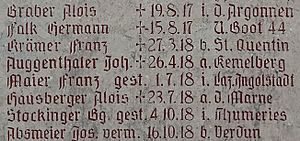
The Allies lost about 255,000 soldiers. The British had 177,739 killed, wounded, or missing. Many of these were from the Fifth and Third Armies. Some divisions, like the 36th (Ulster) Division, lost over 7,000 men and had to be rebuilt.
German losses were around 250,000 men. Many of these were their best stormtrooper units, which were hard to replace. The Germans also lost many guns, machine-guns, and tanks. The failure of Operation Michael was a huge blow to Germany and helped lead to the end of the war.
See also


